Veterinary Terminology: Homeostasis, Diseases, and Treatments Analysis
VerifiedAdded on 2021/04/16
|13
|2712
|46
Homework Assignment
AI Summary
This assignment delves into key aspects of veterinary terminology, beginning with an exploration of homeostasis, its definition, the body systems involved, and the concept of negative feedback systems, along with various homeostatic mechanisms. The assignment then moves on to detailed discussions of specific diseases, including hyperadrenocorticism (Cushing's Syndrome) and hypoadrenocorticism (Addison’s Disease), covering their definitions, causes, clinical signs, diagnostic methods, and treatment options, with a focus on their prevalence in canines and felines. The assignment also explores hypercalcemia and hypocalcemia, providing definitions, causes, clinical signs, diagnostic approaches, and treatment strategies, again noting their occurrence in both canines and felines. Furthermore, the assignment includes an in-depth examination of hyperthyroidism and hypothyroidism, addressing their definitions, causes, clinical signs, diagnostic methods, and treatment options, highlighting their prevalence in canines and felines. Finally, the assignment concludes with an overview of Diabetes Mellitus, discussing its definition, types, causes, risk factors, clinical signs, and treatment options, while also differentiating it from Diabetes Insipidus, providing a comprehensive understanding of these critical veterinary topics.
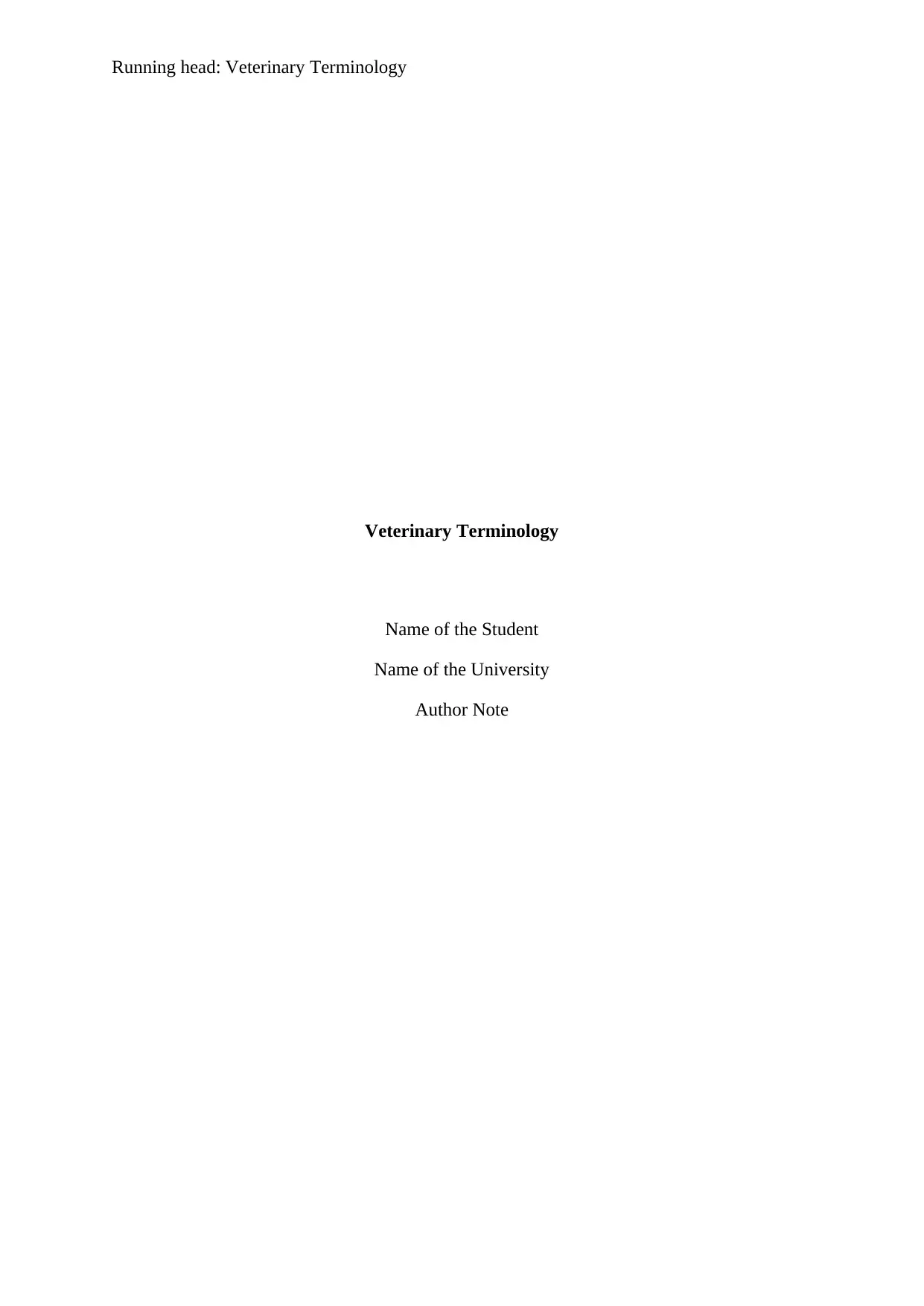
Running head: Veterinary Terminology
Veterinary Terminology
Name of the Student
Name of the University
Author Note
Veterinary Terminology
Name of the Student
Name of the University
Author Note
Paraphrase This Document
Need a fresh take? Get an instant paraphrase of this document with our AI Paraphraser

1Veterinary Terminology
Part 1:
Homeostasis
(Meaning, the body systems that controls homeostasis, what is negative feedback system,
homeostatic mechanisms)
Definition:
Homeostasis can be understood as a self regulating system which allows the
maintenance of stability in biological systems, while adjusting to condition vital for survival.
The stability is a state of dynamic equilibrium where a uniform set of conditions are
maintained through continuous sets of changes (De Luca et al., 2014).
Body Systems Involved in Homeostasis:
Homeostatic system consists of three components: receptor, control and effectors. The
control can either be intrinsic or extrinsic. The Endocrine and the nervous system mostly act
as control systems for homeostasis. (estrellamountain.edu, 2018).
Negative feedback system
Negative feedback system refers to a system where the information provided by the
feedback causes a change that is reverse to the response (estrellamountain.edu, 2018).
Homeostatic control systems:
Different types of variables are controlled by the homeostatic mechanism. These
include: core body temperature, blood glucose, levels of respiratory gases in blood, blood
oxygen levels, arterial blood pressure, level of calcium, concentration of sodium,
concentration of potassium, fluid and osmotic balance, pH of blood, composition of
cerebrospinal fluid, neurotransmission, neuroendocrine system, regulation of gene expression
and energy homeostasis (Nakamura, 2011; Prabhakar & Semenza, 2015; bbc.co.uk, 2018).
Part 1:
Homeostasis
(Meaning, the body systems that controls homeostasis, what is negative feedback system,
homeostatic mechanisms)
Definition:
Homeostasis can be understood as a self regulating system which allows the
maintenance of stability in biological systems, while adjusting to condition vital for survival.
The stability is a state of dynamic equilibrium where a uniform set of conditions are
maintained through continuous sets of changes (De Luca et al., 2014).
Body Systems Involved in Homeostasis:
Homeostatic system consists of three components: receptor, control and effectors. The
control can either be intrinsic or extrinsic. The Endocrine and the nervous system mostly act
as control systems for homeostasis. (estrellamountain.edu, 2018).
Negative feedback system
Negative feedback system refers to a system where the information provided by the
feedback causes a change that is reverse to the response (estrellamountain.edu, 2018).
Homeostatic control systems:
Different types of variables are controlled by the homeostatic mechanism. These
include: core body temperature, blood glucose, levels of respiratory gases in blood, blood
oxygen levels, arterial blood pressure, level of calcium, concentration of sodium,
concentration of potassium, fluid and osmotic balance, pH of blood, composition of
cerebrospinal fluid, neurotransmission, neuroendocrine system, regulation of gene expression
and energy homeostasis (Nakamura, 2011; Prabhakar & Semenza, 2015; bbc.co.uk, 2018).
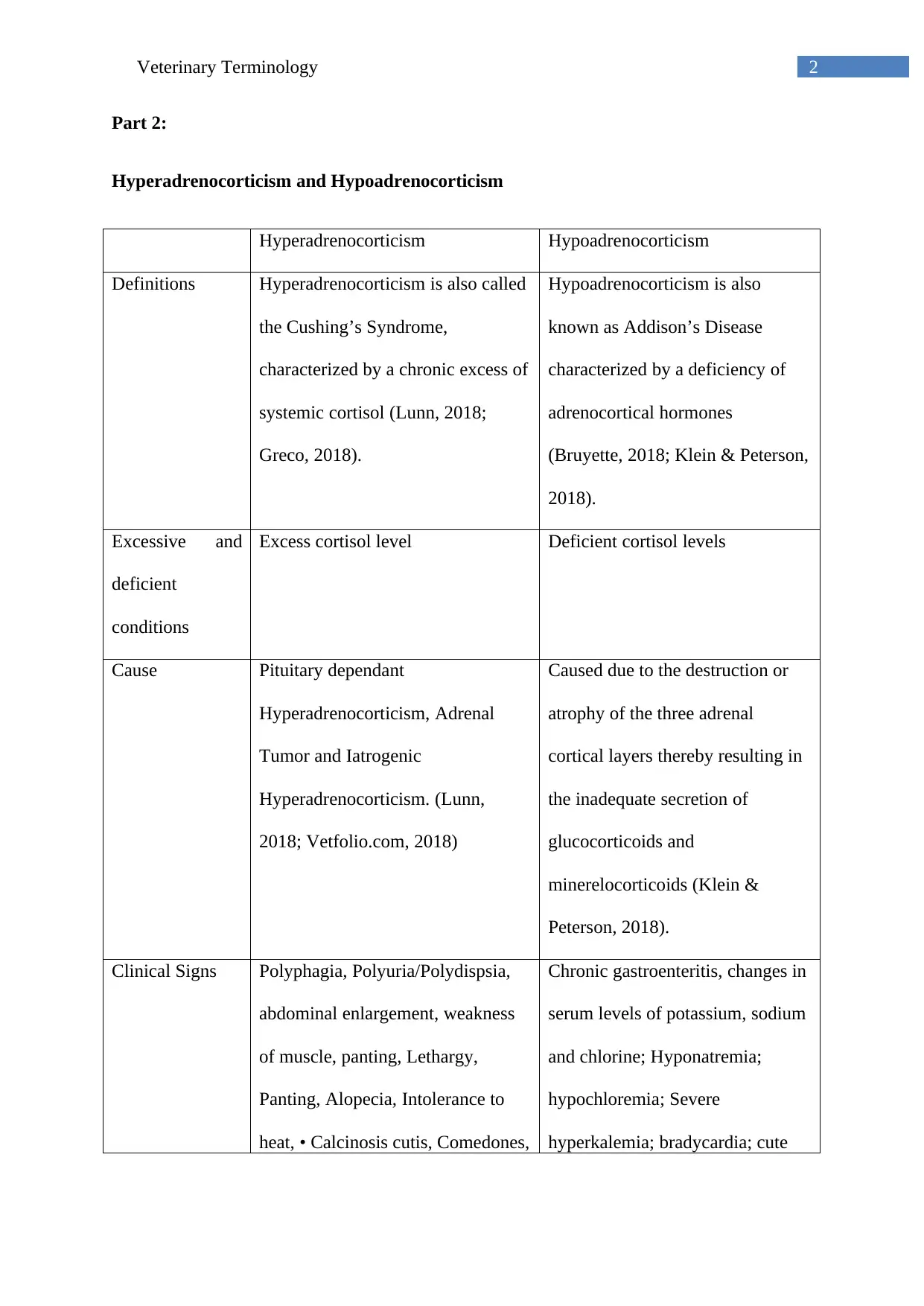
2Veterinary Terminology
Part 2:
Hyperadrenocorticism and Hypoadrenocorticism
Hyperadrenocorticism Hypoadrenocorticism
Definitions Hyperadrenocorticism is also called
the Cushing’s Syndrome,
characterized by a chronic excess of
systemic cortisol (Lunn, 2018;
Greco, 2018).
Hypoadrenocorticism is also
known as Addison’s Disease
characterized by a deficiency of
adrenocortical hormones
(Bruyette, 2018; Klein & Peterson,
2018).
Excessive and
deficient
conditions
Excess cortisol level Deficient cortisol levels
Cause Pituitary dependant
Hyperadrenocorticism, Adrenal
Tumor and Iatrogenic
Hyperadrenocorticism. (Lunn,
2018; Vetfolio.com, 2018)
Caused due to the destruction or
atrophy of the three adrenal
cortical layers thereby resulting in
the inadequate secretion of
glucocorticoids and
minerelocorticoids (Klein &
Peterson, 2018).
Clinical Signs Polyphagia, Polyuria/Polydispsia,
abdominal enlargement, weakness
of muscle, panting, Lethargy,
Panting, Alopecia, Intolerance to
heat, • Calcinosis cutis, Comedones,
Chronic gastroenteritis, changes in
serum levels of potassium, sodium
and chlorine; Hyponatremia;
hypochloremia; Severe
hyperkalemia; bradycardia; cute
Part 2:
Hyperadrenocorticism and Hypoadrenocorticism
Hyperadrenocorticism Hypoadrenocorticism
Definitions Hyperadrenocorticism is also called
the Cushing’s Syndrome,
characterized by a chronic excess of
systemic cortisol (Lunn, 2018;
Greco, 2018).
Hypoadrenocorticism is also
known as Addison’s Disease
characterized by a deficiency of
adrenocortical hormones
(Bruyette, 2018; Klein & Peterson,
2018).
Excessive and
deficient
conditions
Excess cortisol level Deficient cortisol levels
Cause Pituitary dependant
Hyperadrenocorticism, Adrenal
Tumor and Iatrogenic
Hyperadrenocorticism. (Lunn,
2018; Vetfolio.com, 2018)
Caused due to the destruction or
atrophy of the three adrenal
cortical layers thereby resulting in
the inadequate secretion of
glucocorticoids and
minerelocorticoids (Klein &
Peterson, 2018).
Clinical Signs Polyphagia, Polyuria/Polydispsia,
abdominal enlargement, weakness
of muscle, panting, Lethargy,
Panting, Alopecia, Intolerance to
heat, • Calcinosis cutis, Comedones,
Chronic gastroenteritis, changes in
serum levels of potassium, sodium
and chlorine; Hyponatremia;
hypochloremia; Severe
hyperkalemia; bradycardia; cute
⊘ This is a preview!⊘
Do you want full access?
Subscribe today to unlock all pages.

Trusted by 1+ million students worldwide

3Veterinary Terminology
Thin skin, bruising, striae,
Hyperpigmentation, • Testicular
atrophy, Pseudomyotonia, Anestrus,
• Seborrhea, pyoderma and Facial
paralysis (Lunn, 2018).
circulatory collapse; renal failure;
hypotension; weakness;
microcardia; progressive
dehydration; hemoconcentration;
Emesis; diarrhea; anorexia; weight
loss; hypoglycemia; and skin
hyperpigmentation (Bryutte, 2018;
Klein & Peterson, 2018).
Diagnosis Urine cortisol to Creatinine ratio;
Adrenocorticotropic stimulation
test; intravenous low-dose and oral
dexamethasone suppression test;
high-dose dexamethasone
suppression test and Measurement
of endogenous plasma
Adrenocorticotropic concentrations
(Greco, 2018). Complete Blood
Count, Serum Biochemistry,
Urianalysis. Diagnostic imaging
techniques like: Abdominal
radiograph, thoracic radiograph,
abdominal ultrasound exam, brain
CT scan or Magnetic Resonance
Imaging (Lunn, 2018).
The condition can be diagnosed on
the basis of compatible history,
clinical signs, laboratory
abnormalities, imaging studies and
adrenocorticotropic hormone
stimulation test results. Diagnostic
imaging can include: thoracic
radiograph, abdominal
ultrasonography,
electrocardiogram (Lottati &
Bruyette, 2018).
Treatment Surgical Intervention for Acute medical emergency is
Thin skin, bruising, striae,
Hyperpigmentation, • Testicular
atrophy, Pseudomyotonia, Anestrus,
• Seborrhea, pyoderma and Facial
paralysis (Lunn, 2018).
circulatory collapse; renal failure;
hypotension; weakness;
microcardia; progressive
dehydration; hemoconcentration;
Emesis; diarrhea; anorexia; weight
loss; hypoglycemia; and skin
hyperpigmentation (Bryutte, 2018;
Klein & Peterson, 2018).
Diagnosis Urine cortisol to Creatinine ratio;
Adrenocorticotropic stimulation
test; intravenous low-dose and oral
dexamethasone suppression test;
high-dose dexamethasone
suppression test and Measurement
of endogenous plasma
Adrenocorticotropic concentrations
(Greco, 2018). Complete Blood
Count, Serum Biochemistry,
Urianalysis. Diagnostic imaging
techniques like: Abdominal
radiograph, thoracic radiograph,
abdominal ultrasound exam, brain
CT scan or Magnetic Resonance
Imaging (Lunn, 2018).
The condition can be diagnosed on
the basis of compatible history,
clinical signs, laboratory
abnormalities, imaging studies and
adrenocorticotropic hormone
stimulation test results. Diagnostic
imaging can include: thoracic
radiograph, abdominal
ultrasonography,
electrocardiogram (Lottati &
Bruyette, 2018).
Treatment Surgical Intervention for Acute medical emergency is
Paraphrase This Document
Need a fresh take? Get an instant paraphrase of this document with our AI Paraphraser

4Veterinary Terminology
adrenocortical tumours or pituitary
tumours. Medical therapy: mitotane,
trilostane, ketoconazole and l-
deprenyl (vetfolio.com, 2018; Lunn,
2018).
needed for adrenal crisis. The
treatment should include:
intravenous drip of saline solution;
prednisolone sodium succinate or
dexamethasone sodium phosphate
(for shock); prednisone or
prednisolone; minerelocorticoid
replacement therapy; regular
monitoring of renal function,
electrolyte and glucose levels;
administration of insulin (Bruyette,
2018).
Whether
common in
canine/feline/bot
h
Canine Canine
Hypercalcemia and Hypocalcemia
Hypercalcemia Hypocalcemia
Definitions Hypercalcemia occurs when the
concentration of serum calcium is
more than 12mg/dL or ionized
calcium is greater than 1.4mmol/L
(Nelson, 2018).
This condition is characterized
by low levels of calcium in
blood due to vitamin D
inadequacy, hypoparathyroidism
or resistance to these hormones
adrenocortical tumours or pituitary
tumours. Medical therapy: mitotane,
trilostane, ketoconazole and l-
deprenyl (vetfolio.com, 2018; Lunn,
2018).
needed for adrenal crisis. The
treatment should include:
intravenous drip of saline solution;
prednisolone sodium succinate or
dexamethasone sodium phosphate
(for shock); prednisone or
prednisolone; minerelocorticoid
replacement therapy; regular
monitoring of renal function,
electrolyte and glucose levels;
administration of insulin (Bruyette,
2018).
Whether
common in
canine/feline/bot
h
Canine Canine
Hypercalcemia and Hypocalcemia
Hypercalcemia Hypocalcemia
Definitions Hypercalcemia occurs when the
concentration of serum calcium is
more than 12mg/dL or ionized
calcium is greater than 1.4mmol/L
(Nelson, 2018).
This condition is characterized
by low levels of calcium in
blood due to vitamin D
inadequacy, hypoparathyroidism
or resistance to these hormones
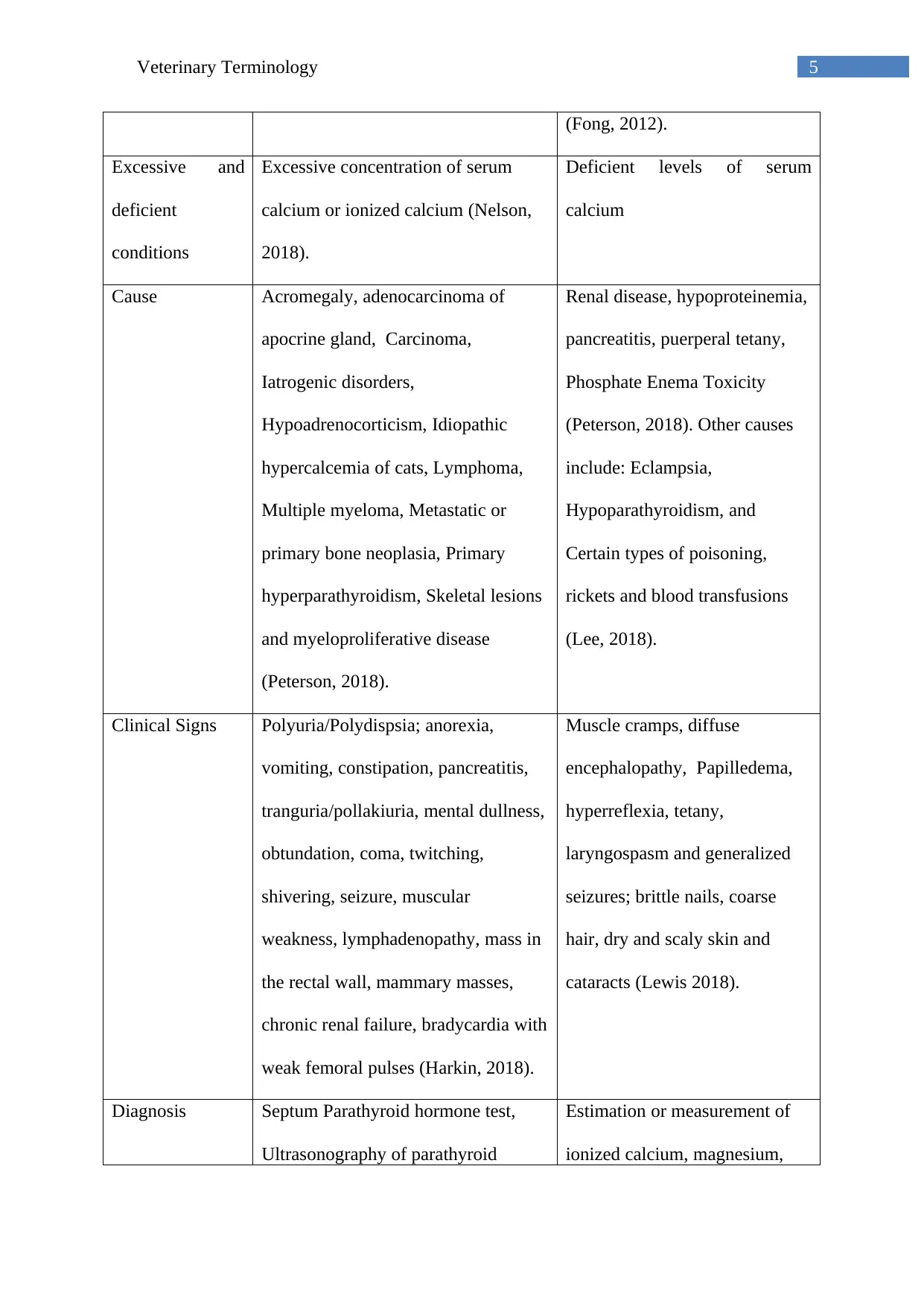
5Veterinary Terminology
(Fong, 2012).
Excessive and
deficient
conditions
Excessive concentration of serum
calcium or ionized calcium (Nelson,
2018).
Deficient levels of serum
calcium
Cause Acromegaly, adenocarcinoma of
apocrine gland, Carcinoma,
Iatrogenic disorders,
Hypoadrenocorticism, Idiopathic
hypercalcemia of cats, Lymphoma,
Multiple myeloma, Metastatic or
primary bone neoplasia, Primary
hyperparathyroidism, Skeletal lesions
and myeloproliferative disease
(Peterson, 2018).
Renal disease, hypoproteinemia,
pancreatitis, puerperal tetany,
Phosphate Enema Toxicity
(Peterson, 2018). Other causes
include: Eclampsia,
Hypoparathyroidism, and
Certain types of poisoning,
rickets and blood transfusions
(Lee, 2018).
Clinical Signs Polyuria/Polydispsia; anorexia,
vomiting, constipation, pancreatitis,
tranguria/pollakiuria, mental dullness,
obtundation, coma, twitching,
shivering, seizure, muscular
weakness, lymphadenopathy, mass in
the rectal wall, mammary masses,
chronic renal failure, bradycardia with
weak femoral pulses (Harkin, 2018).
Muscle cramps, diffuse
encephalopathy, Papilledema,
hyperreflexia, tetany,
laryngospasm and generalized
seizures; brittle nails, coarse
hair, dry and scaly skin and
cataracts (Lewis 2018).
Diagnosis Septum Parathyroid hormone test,
Ultrasonography of parathyroid
Estimation or measurement of
ionized calcium, magnesium,
(Fong, 2012).
Excessive and
deficient
conditions
Excessive concentration of serum
calcium or ionized calcium (Nelson,
2018).
Deficient levels of serum
calcium
Cause Acromegaly, adenocarcinoma of
apocrine gland, Carcinoma,
Iatrogenic disorders,
Hypoadrenocorticism, Idiopathic
hypercalcemia of cats, Lymphoma,
Multiple myeloma, Metastatic or
primary bone neoplasia, Primary
hyperparathyroidism, Skeletal lesions
and myeloproliferative disease
(Peterson, 2018).
Renal disease, hypoproteinemia,
pancreatitis, puerperal tetany,
Phosphate Enema Toxicity
(Peterson, 2018). Other causes
include: Eclampsia,
Hypoparathyroidism, and
Certain types of poisoning,
rickets and blood transfusions
(Lee, 2018).
Clinical Signs Polyuria/Polydispsia; anorexia,
vomiting, constipation, pancreatitis,
tranguria/pollakiuria, mental dullness,
obtundation, coma, twitching,
shivering, seizure, muscular
weakness, lymphadenopathy, mass in
the rectal wall, mammary masses,
chronic renal failure, bradycardia with
weak femoral pulses (Harkin, 2018).
Muscle cramps, diffuse
encephalopathy, Papilledema,
hyperreflexia, tetany,
laryngospasm and generalized
seizures; brittle nails, coarse
hair, dry and scaly skin and
cataracts (Lewis 2018).
Diagnosis Septum Parathyroid hormone test,
Ultrasonography of parathyroid
Estimation or measurement of
ionized calcium, magnesium,
⊘ This is a preview!⊘
Do you want full access?
Subscribe today to unlock all pages.

Trusted by 1+ million students worldwide
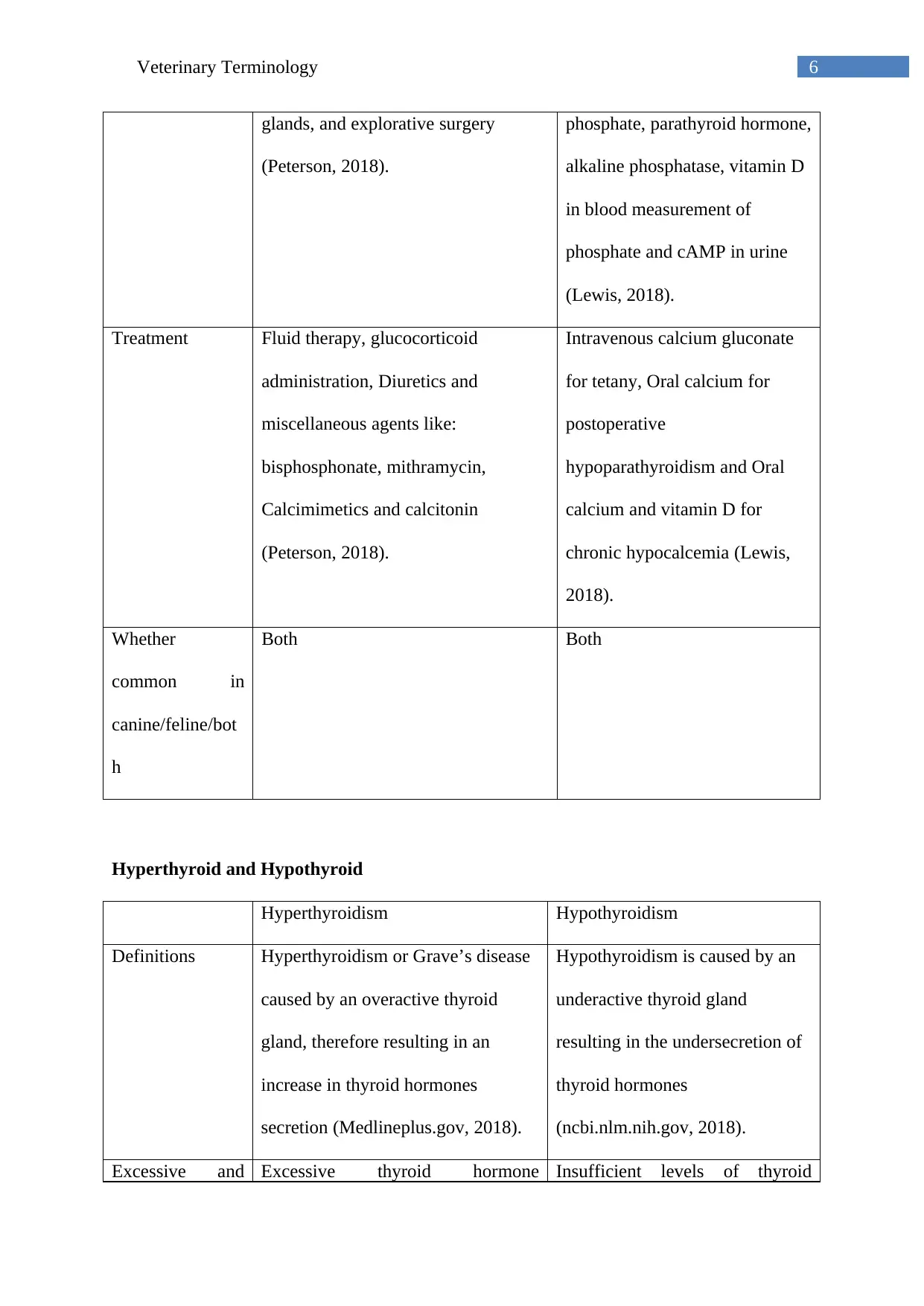
6Veterinary Terminology
glands, and explorative surgery
(Peterson, 2018).
phosphate, parathyroid hormone,
alkaline phosphatase, vitamin D
in blood measurement of
phosphate and cAMP in urine
(Lewis, 2018).
Treatment Fluid therapy, glucocorticoid
administration, Diuretics and
miscellaneous agents like:
bisphosphonate, mithramycin,
Calcimimetics and calcitonin
(Peterson, 2018).
Intravenous calcium gluconate
for tetany, Oral calcium for
postoperative
hypoparathyroidism and Oral
calcium and vitamin D for
chronic hypocalcemia (Lewis,
2018).
Whether
common in
canine/feline/bot
h
Both Both
Hyperthyroid and Hypothyroid
Hyperthyroidism Hypothyroidism
Definitions Hyperthyroidism or Grave’s disease
caused by an overactive thyroid
gland, therefore resulting in an
increase in thyroid hormones
secretion (Medlineplus.gov, 2018).
Hypothyroidism is caused by an
underactive thyroid gland
resulting in the undersecretion of
thyroid hormones
(ncbi.nlm.nih.gov, 2018).
Excessive and Excessive thyroid hormone Insufficient levels of thyroid
glands, and explorative surgery
(Peterson, 2018).
phosphate, parathyroid hormone,
alkaline phosphatase, vitamin D
in blood measurement of
phosphate and cAMP in urine
(Lewis, 2018).
Treatment Fluid therapy, glucocorticoid
administration, Diuretics and
miscellaneous agents like:
bisphosphonate, mithramycin,
Calcimimetics and calcitonin
(Peterson, 2018).
Intravenous calcium gluconate
for tetany, Oral calcium for
postoperative
hypoparathyroidism and Oral
calcium and vitamin D for
chronic hypocalcemia (Lewis,
2018).
Whether
common in
canine/feline/bot
h
Both Both
Hyperthyroid and Hypothyroid
Hyperthyroidism Hypothyroidism
Definitions Hyperthyroidism or Grave’s disease
caused by an overactive thyroid
gland, therefore resulting in an
increase in thyroid hormones
secretion (Medlineplus.gov, 2018).
Hypothyroidism is caused by an
underactive thyroid gland
resulting in the undersecretion of
thyroid hormones
(ncbi.nlm.nih.gov, 2018).
Excessive and Excessive thyroid hormone Insufficient levels of thyroid
Paraphrase This Document
Need a fresh take? Get an instant paraphrase of this document with our AI Paraphraser
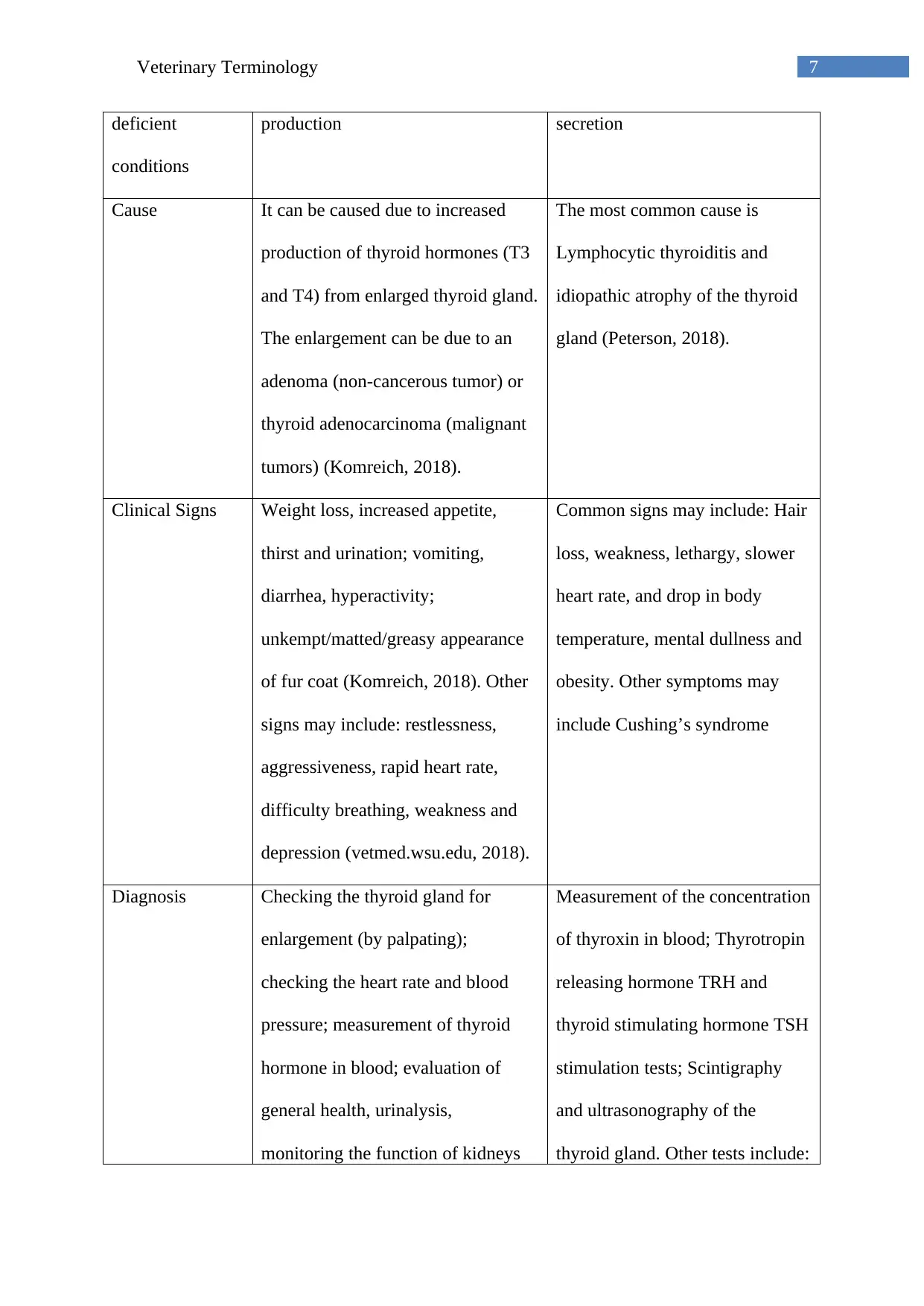
7Veterinary Terminology
deficient
conditions
production secretion
Cause It can be caused due to increased
production of thyroid hormones (T3
and T4) from enlarged thyroid gland.
The enlargement can be due to an
adenoma (non-cancerous tumor) or
thyroid adenocarcinoma (malignant
tumors) (Komreich, 2018).
The most common cause is
Lymphocytic thyroiditis and
idiopathic atrophy of the thyroid
gland (Peterson, 2018).
Clinical Signs Weight loss, increased appetite,
thirst and urination; vomiting,
diarrhea, hyperactivity;
unkempt/matted/greasy appearance
of fur coat (Komreich, 2018). Other
signs may include: restlessness,
aggressiveness, rapid heart rate,
difficulty breathing, weakness and
depression (vetmed.wsu.edu, 2018).
Common signs may include: Hair
loss, weakness, lethargy, slower
heart rate, and drop in body
temperature, mental dullness and
obesity. Other symptoms may
include Cushing’s syndrome
Diagnosis Checking the thyroid gland for
enlargement (by palpating);
checking the heart rate and blood
pressure; measurement of thyroid
hormone in blood; evaluation of
general health, urinalysis,
monitoring the function of kidneys
Measurement of the concentration
of thyroxin in blood; Thyrotropin
releasing hormone TRH and
thyroid stimulating hormone TSH
stimulation tests; Scintigraphy
and ultrasonography of the
thyroid gland. Other tests include:
deficient
conditions
production secretion
Cause It can be caused due to increased
production of thyroid hormones (T3
and T4) from enlarged thyroid gland.
The enlargement can be due to an
adenoma (non-cancerous tumor) or
thyroid adenocarcinoma (malignant
tumors) (Komreich, 2018).
The most common cause is
Lymphocytic thyroiditis and
idiopathic atrophy of the thyroid
gland (Peterson, 2018).
Clinical Signs Weight loss, increased appetite,
thirst and urination; vomiting,
diarrhea, hyperactivity;
unkempt/matted/greasy appearance
of fur coat (Komreich, 2018). Other
signs may include: restlessness,
aggressiveness, rapid heart rate,
difficulty breathing, weakness and
depression (vetmed.wsu.edu, 2018).
Common signs may include: Hair
loss, weakness, lethargy, slower
heart rate, and drop in body
temperature, mental dullness and
obesity. Other symptoms may
include Cushing’s syndrome
Diagnosis Checking the thyroid gland for
enlargement (by palpating);
checking the heart rate and blood
pressure; measurement of thyroid
hormone in blood; evaluation of
general health, urinalysis,
monitoring the function of kidneys
Measurement of the concentration
of thyroxin in blood; Thyrotropin
releasing hormone TRH and
thyroid stimulating hormone TSH
stimulation tests; Scintigraphy
and ultrasonography of the
thyroid gland. Other tests include:
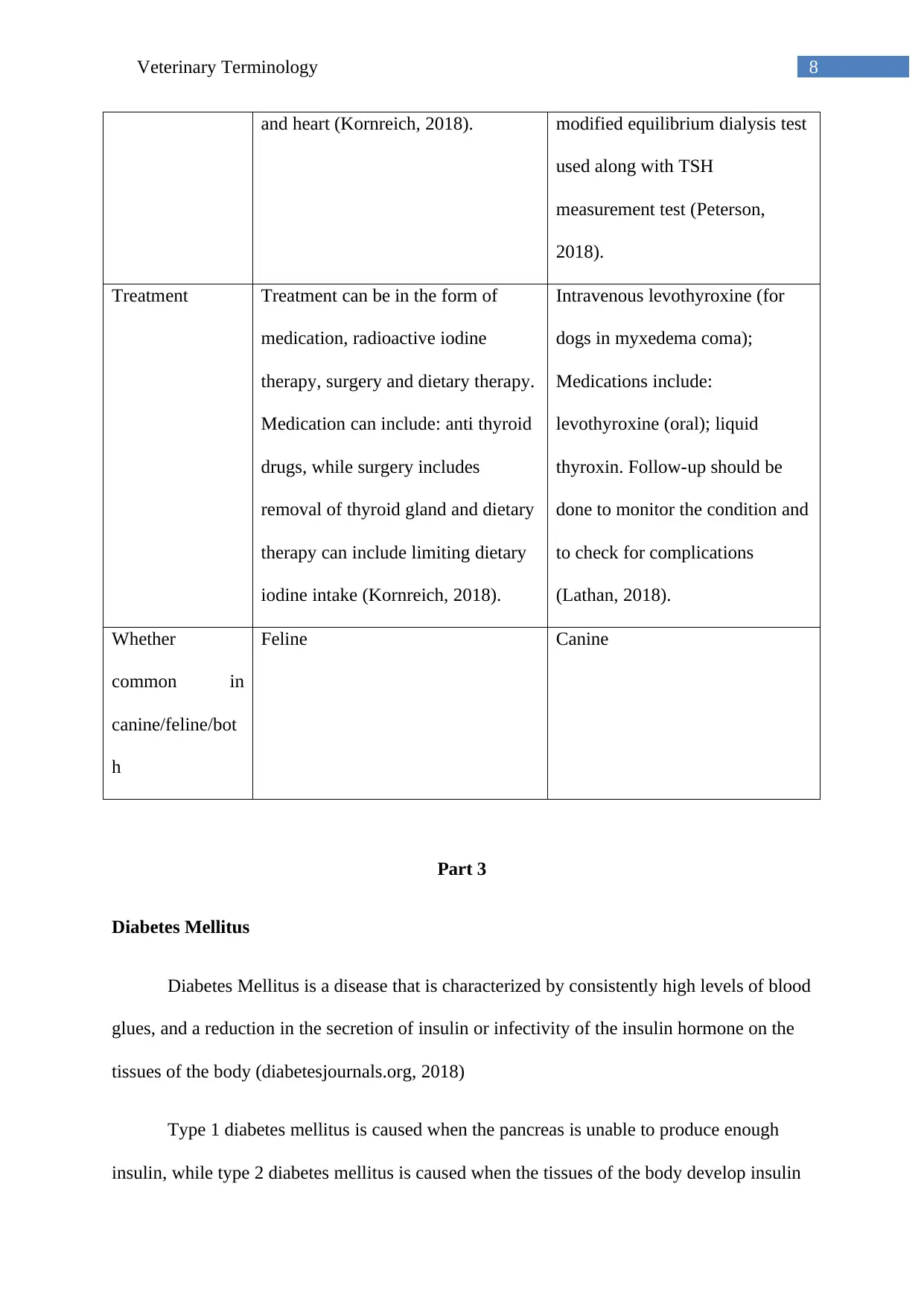
8Veterinary Terminology
and heart (Kornreich, 2018). modified equilibrium dialysis test
used along with TSH
measurement test (Peterson,
2018).
Treatment Treatment can be in the form of
medication, radioactive iodine
therapy, surgery and dietary therapy.
Medication can include: anti thyroid
drugs, while surgery includes
removal of thyroid gland and dietary
therapy can include limiting dietary
iodine intake (Kornreich, 2018).
Intravenous levothyroxine (for
dogs in myxedema coma);
Medications include:
levothyroxine (oral); liquid
thyroxin. Follow-up should be
done to monitor the condition and
to check for complications
(Lathan, 2018).
Whether
common in
canine/feline/bot
h
Feline Canine
Part 3
Diabetes Mellitus
Diabetes Mellitus is a disease that is characterized by consistently high levels of blood
glues, and a reduction in the secretion of insulin or infectivity of the insulin hormone on the
tissues of the body (diabetesjournals.org, 2018)
Type 1 diabetes mellitus is caused when the pancreas is unable to produce enough
insulin, while type 2 diabetes mellitus is caused when the tissues of the body develop insulin
and heart (Kornreich, 2018). modified equilibrium dialysis test
used along with TSH
measurement test (Peterson,
2018).
Treatment Treatment can be in the form of
medication, radioactive iodine
therapy, surgery and dietary therapy.
Medication can include: anti thyroid
drugs, while surgery includes
removal of thyroid gland and dietary
therapy can include limiting dietary
iodine intake (Kornreich, 2018).
Intravenous levothyroxine (for
dogs in myxedema coma);
Medications include:
levothyroxine (oral); liquid
thyroxin. Follow-up should be
done to monitor the condition and
to check for complications
(Lathan, 2018).
Whether
common in
canine/feline/bot
h
Feline Canine
Part 3
Diabetes Mellitus
Diabetes Mellitus is a disease that is characterized by consistently high levels of blood
glues, and a reduction in the secretion of insulin or infectivity of the insulin hormone on the
tissues of the body (diabetesjournals.org, 2018)
Type 1 diabetes mellitus is caused when the pancreas is unable to produce enough
insulin, while type 2 diabetes mellitus is caused when the tissues of the body develop insulin
⊘ This is a preview!⊘
Do you want full access?
Subscribe today to unlock all pages.

Trusted by 1+ million students worldwide

9Veterinary Terminology
resistance, and they fail to appropriately respond to the hormone (diabetes.co.uk, 2018). Type
1 can further be divided into immune mediated diabetes and idiopathic diabetes
(diabetesjournals.org, 2018).
Causes of Diabetes include the autoimmune destruction of pancreatic beta cells,
resistance to insulin (diabetesjournals.org, 2018). Several factors can increase the risks to
diabetes and includes: family history of the disease; ethnicity; overweight/obesity; stress;
some types of medications; pancreatic injury; autoimmune dysfunction; hypertension; high
blood cholesterol levels; age; smoking and alcoholism and pregnancy (clevelandclinic.org,
2018).
Signs of diabetes are: increased hunger and thirst; dryness of mouth; urinating
frequently; sudden loss of weight; blurring of vision; weakness; tingling and numbness in feet
and hands; longer time for the healing of wounds; dryness of skin and yeast infections
(clevelandclinic.org, 2018).
Treatment options are: diet change; oral medications; exercise; insulin treatment;
identification and treatment of concurrent diseases (Kow, 2018).
Difference with diabetes insipidus: Diabetes Insipidus however is another type of
diabetes that is caused due to inadequate production of Arginine Vasopressin hormone or an
inability of the distal tubule/collecting ducts of the nephron to respond to it (Rossi & Ross,
2018).
resistance, and they fail to appropriately respond to the hormone (diabetes.co.uk, 2018). Type
1 can further be divided into immune mediated diabetes and idiopathic diabetes
(diabetesjournals.org, 2018).
Causes of Diabetes include the autoimmune destruction of pancreatic beta cells,
resistance to insulin (diabetesjournals.org, 2018). Several factors can increase the risks to
diabetes and includes: family history of the disease; ethnicity; overweight/obesity; stress;
some types of medications; pancreatic injury; autoimmune dysfunction; hypertension; high
blood cholesterol levels; age; smoking and alcoholism and pregnancy (clevelandclinic.org,
2018).
Signs of diabetes are: increased hunger and thirst; dryness of mouth; urinating
frequently; sudden loss of weight; blurring of vision; weakness; tingling and numbness in feet
and hands; longer time for the healing of wounds; dryness of skin and yeast infections
(clevelandclinic.org, 2018).
Treatment options are: diet change; oral medications; exercise; insulin treatment;
identification and treatment of concurrent diseases (Kow, 2018).
Difference with diabetes insipidus: Diabetes Insipidus however is another type of
diabetes that is caused due to inadequate production of Arginine Vasopressin hormone or an
inability of the distal tubule/collecting ducts of the nephron to respond to it (Rossi & Ross,
2018).
Paraphrase This Document
Need a fresh take? Get an instant paraphrase of this document with our AI Paraphraser
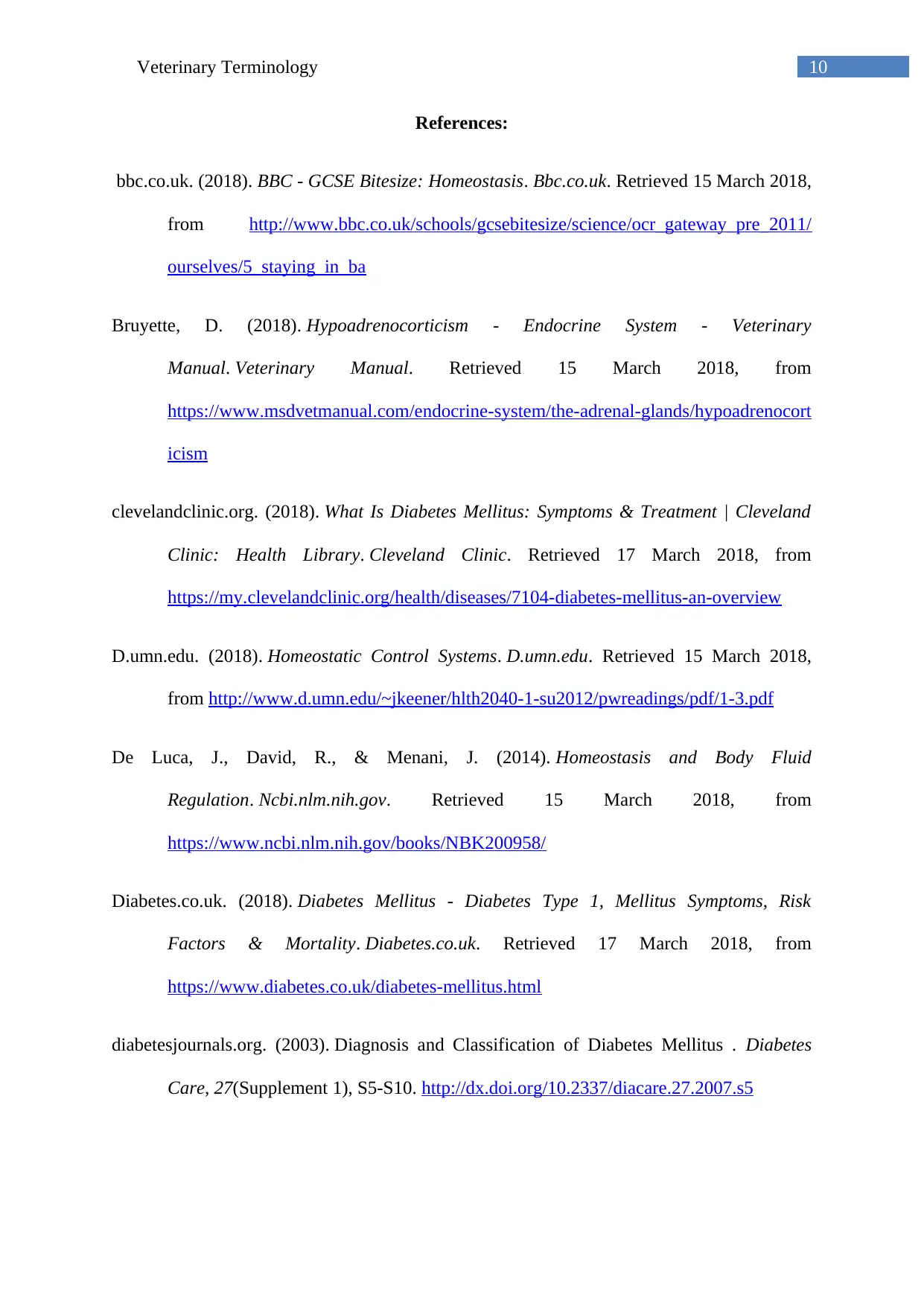
10Veterinary Terminology
References:
bbc.co.uk. (2018). BBC - GCSE Bitesize: Homeostasis. Bbc.co.uk. Retrieved 15 March 2018,
from http://www.bbc.co.uk/schools/gcsebitesize/science/ocr_gateway_pre_2011/
ourselves/5_staying_in_ba
Bruyette, D. (2018). Hypoadrenocorticism - Endocrine System - Veterinary
Manual. Veterinary Manual. Retrieved 15 March 2018, from
https://www.msdvetmanual.com/endocrine-system/the-adrenal-glands/hypoadrenocort
icism
clevelandclinic.org. (2018). What Is Diabetes Mellitus: Symptoms & Treatment | Cleveland
Clinic: Health Library. Cleveland Clinic. Retrieved 17 March 2018, from
https://my.clevelandclinic.org/health/diseases/7104-diabetes-mellitus-an-overview
D.umn.edu. (2018). Homeostatic Control Systems. D.umn.edu. Retrieved 15 March 2018,
from http://www.d.umn.edu/~jkeener/hlth2040-1-su2012/pwreadings/pdf/1-3.pdf
De Luca, J., David, R., & Menani, J. (2014). Homeostasis and Body Fluid
Regulation. Ncbi.nlm.nih.gov. Retrieved 15 March 2018, from
https://www.ncbi.nlm.nih.gov/books/NBK200958/
Diabetes.co.uk. (2018). Diabetes Mellitus - Diabetes Type 1, Mellitus Symptoms, Risk
Factors & Mortality. Diabetes.co.uk. Retrieved 17 March 2018, from
https://www.diabetes.co.uk/diabetes-mellitus.html
diabetesjournals.org. (2003). Diagnosis and Classification of Diabetes Mellitus . Diabetes
Care, 27(Supplement 1), S5-S10. http://dx.doi.org/10.2337/diacare.27.2007.s5
References:
bbc.co.uk. (2018). BBC - GCSE Bitesize: Homeostasis. Bbc.co.uk. Retrieved 15 March 2018,
from http://www.bbc.co.uk/schools/gcsebitesize/science/ocr_gateway_pre_2011/
ourselves/5_staying_in_ba
Bruyette, D. (2018). Hypoadrenocorticism - Endocrine System - Veterinary
Manual. Veterinary Manual. Retrieved 15 March 2018, from
https://www.msdvetmanual.com/endocrine-system/the-adrenal-glands/hypoadrenocort
icism
clevelandclinic.org. (2018). What Is Diabetes Mellitus: Symptoms & Treatment | Cleveland
Clinic: Health Library. Cleveland Clinic. Retrieved 17 March 2018, from
https://my.clevelandclinic.org/health/diseases/7104-diabetes-mellitus-an-overview
D.umn.edu. (2018). Homeostatic Control Systems. D.umn.edu. Retrieved 15 March 2018,
from http://www.d.umn.edu/~jkeener/hlth2040-1-su2012/pwreadings/pdf/1-3.pdf
De Luca, J., David, R., & Menani, J. (2014). Homeostasis and Body Fluid
Regulation. Ncbi.nlm.nih.gov. Retrieved 15 March 2018, from
https://www.ncbi.nlm.nih.gov/books/NBK200958/
Diabetes.co.uk. (2018). Diabetes Mellitus - Diabetes Type 1, Mellitus Symptoms, Risk
Factors & Mortality. Diabetes.co.uk. Retrieved 17 March 2018, from
https://www.diabetes.co.uk/diabetes-mellitus.html
diabetesjournals.org. (2003). Diagnosis and Classification of Diabetes Mellitus . Diabetes
Care, 27(Supplement 1), S5-S10. http://dx.doi.org/10.2337/diacare.27.2007.s5
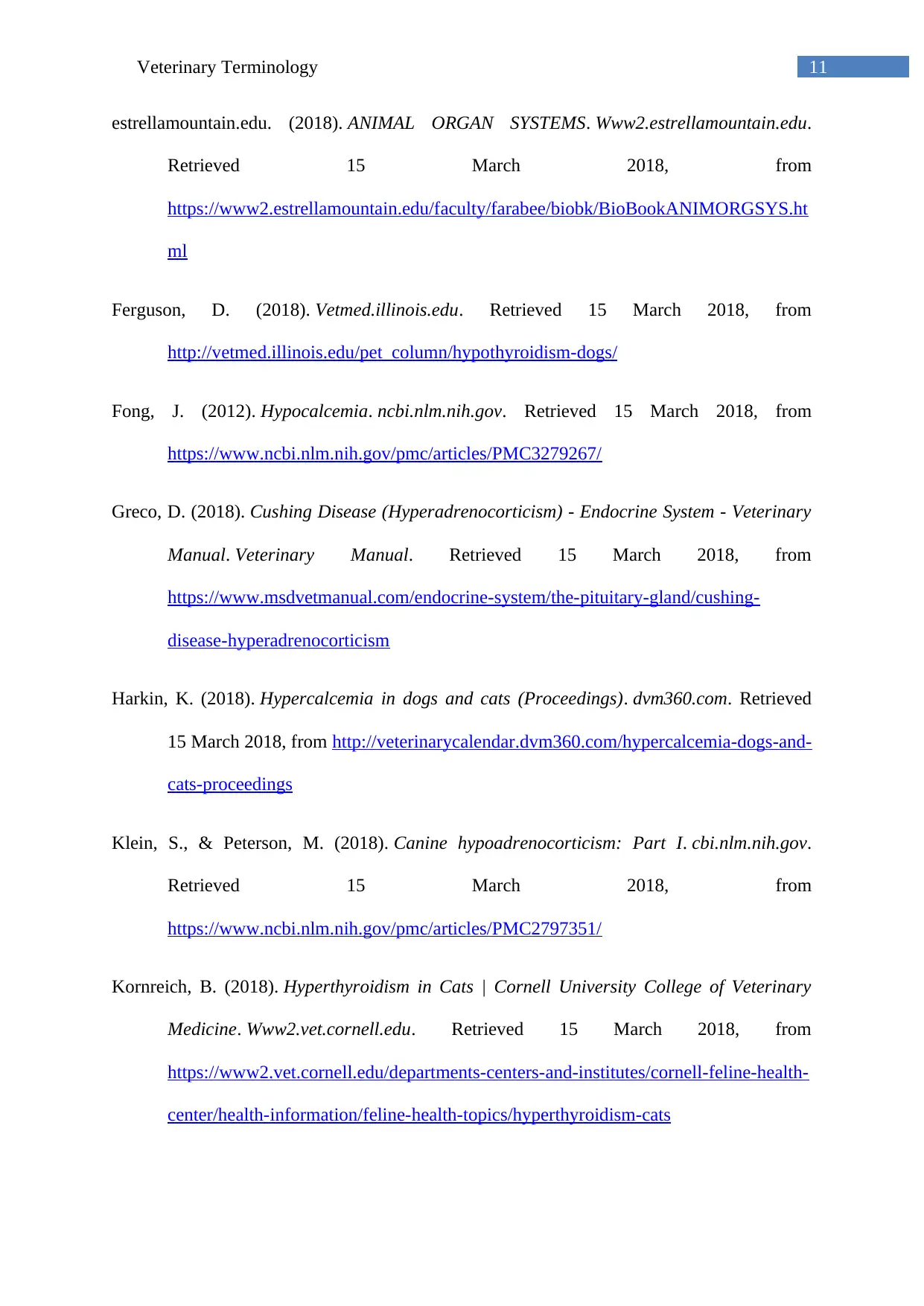
11Veterinary Terminology
estrellamountain.edu. (2018). ANIMAL ORGAN SYSTEMS. Www2.estrellamountain.edu.
Retrieved 15 March 2018, from
https://www2.estrellamountain.edu/faculty/farabee/biobk/BioBookANIMORGSYS.ht
ml
Ferguson, D. (2018). Vetmed.illinois.edu. Retrieved 15 March 2018, from
http://vetmed.illinois.edu/pet_column/hypothyroidism-dogs/
Fong, J. (2012). Hypocalcemia. ncbi.nlm.nih.gov. Retrieved 15 March 2018, from
https://www.ncbi.nlm.nih.gov/pmc/articles/PMC3279267/
Greco, D. (2018). Cushing Disease (Hyperadrenocorticism) - Endocrine System - Veterinary
Manual. Veterinary Manual. Retrieved 15 March 2018, from
https://www.msdvetmanual.com/endocrine-system/the-pituitary-gland/cushing-
disease-hyperadrenocorticism
Harkin, K. (2018). Hypercalcemia in dogs and cats (Proceedings). dvm360.com. Retrieved
15 March 2018, from http://veterinarycalendar.dvm360.com/hypercalcemia-dogs-and-
cats-proceedings
Klein, S., & Peterson, M. (2018). Canine hypoadrenocorticism: Part I. cbi.nlm.nih.gov.
Retrieved 15 March 2018, from
https://www.ncbi.nlm.nih.gov/pmc/articles/PMC2797351/
Kornreich, B. (2018). Hyperthyroidism in Cats | Cornell University College of Veterinary
Medicine. Www2.vet.cornell.edu. Retrieved 15 March 2018, from
https://www2.vet.cornell.edu/departments-centers-and-institutes/cornell-feline-health-
center/health-information/feline-health-topics/hyperthyroidism-cats
estrellamountain.edu. (2018). ANIMAL ORGAN SYSTEMS. Www2.estrellamountain.edu.
Retrieved 15 March 2018, from
https://www2.estrellamountain.edu/faculty/farabee/biobk/BioBookANIMORGSYS.ht
ml
Ferguson, D. (2018). Vetmed.illinois.edu. Retrieved 15 March 2018, from
http://vetmed.illinois.edu/pet_column/hypothyroidism-dogs/
Fong, J. (2012). Hypocalcemia. ncbi.nlm.nih.gov. Retrieved 15 March 2018, from
https://www.ncbi.nlm.nih.gov/pmc/articles/PMC3279267/
Greco, D. (2018). Cushing Disease (Hyperadrenocorticism) - Endocrine System - Veterinary
Manual. Veterinary Manual. Retrieved 15 March 2018, from
https://www.msdvetmanual.com/endocrine-system/the-pituitary-gland/cushing-
disease-hyperadrenocorticism
Harkin, K. (2018). Hypercalcemia in dogs and cats (Proceedings). dvm360.com. Retrieved
15 March 2018, from http://veterinarycalendar.dvm360.com/hypercalcemia-dogs-and-
cats-proceedings
Klein, S., & Peterson, M. (2018). Canine hypoadrenocorticism: Part I. cbi.nlm.nih.gov.
Retrieved 15 March 2018, from
https://www.ncbi.nlm.nih.gov/pmc/articles/PMC2797351/
Kornreich, B. (2018). Hyperthyroidism in Cats | Cornell University College of Veterinary
Medicine. Www2.vet.cornell.edu. Retrieved 15 March 2018, from
https://www2.vet.cornell.edu/departments-centers-and-institutes/cornell-feline-health-
center/health-information/feline-health-topics/hyperthyroidism-cats
⊘ This is a preview!⊘
Do you want full access?
Subscribe today to unlock all pages.

Trusted by 1+ million students worldwide
1 out of 13
Your All-in-One AI-Powered Toolkit for Academic Success.
+13062052269
info@desklib.com
Available 24*7 on WhatsApp / Email
![[object Object]](/_next/static/media/star-bottom.7253800d.svg)
Unlock your academic potential
Copyright © 2020–2025 A2Z Services. All Rights Reserved. Developed and managed by ZUCOL.
